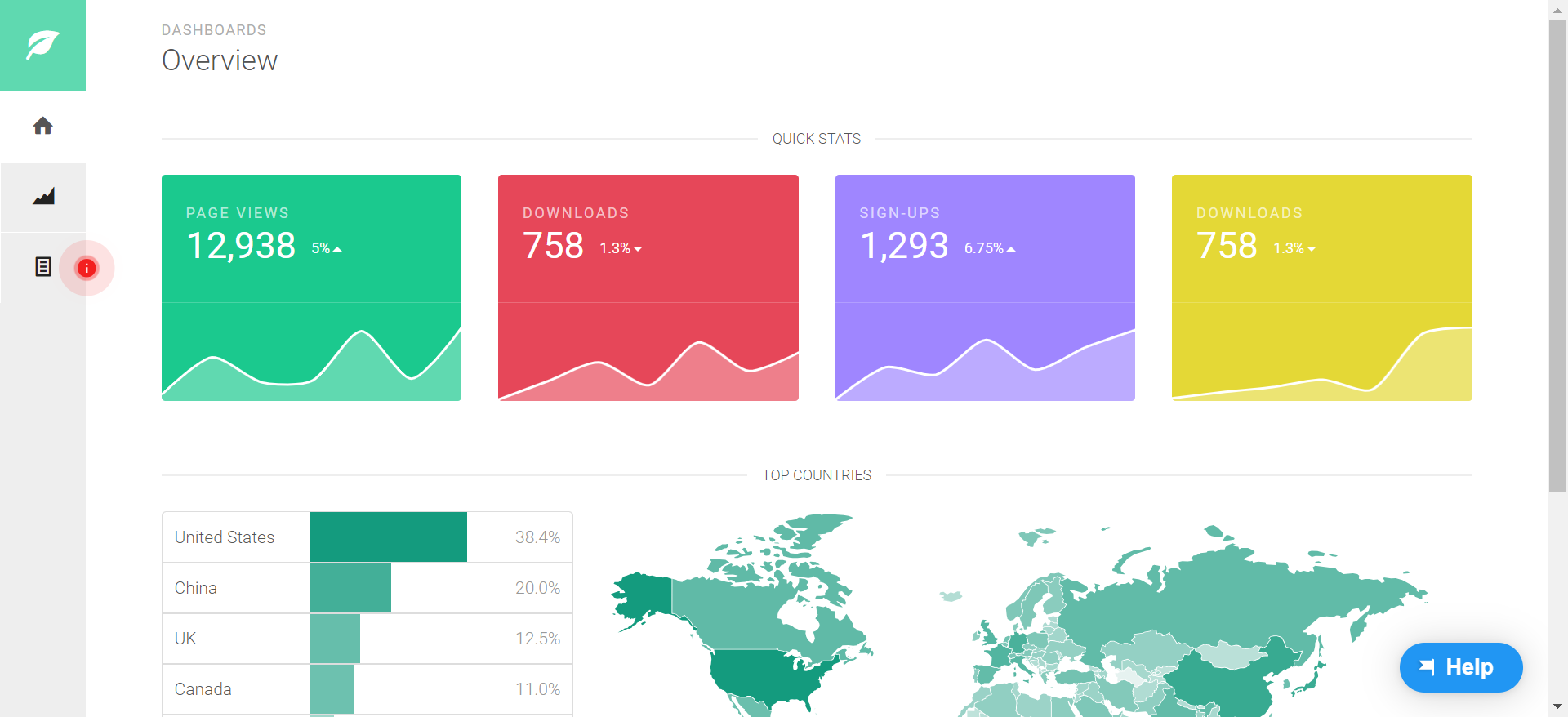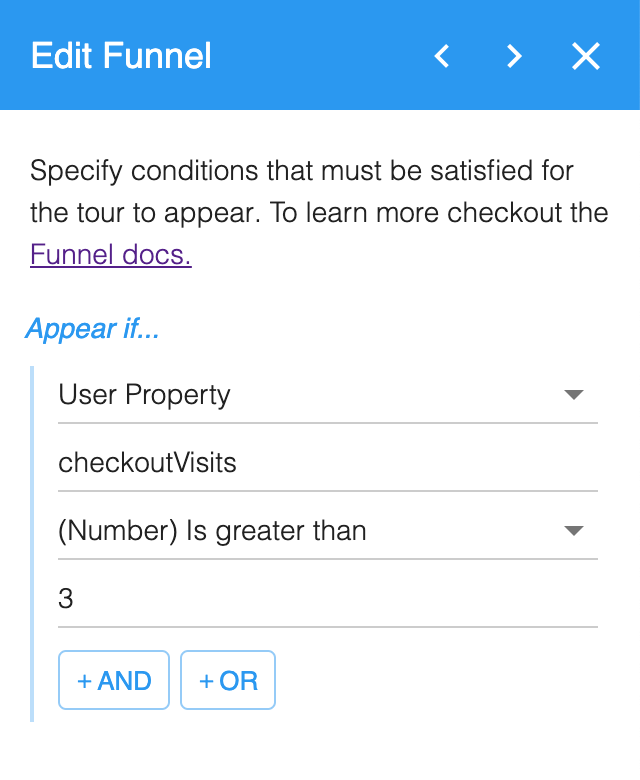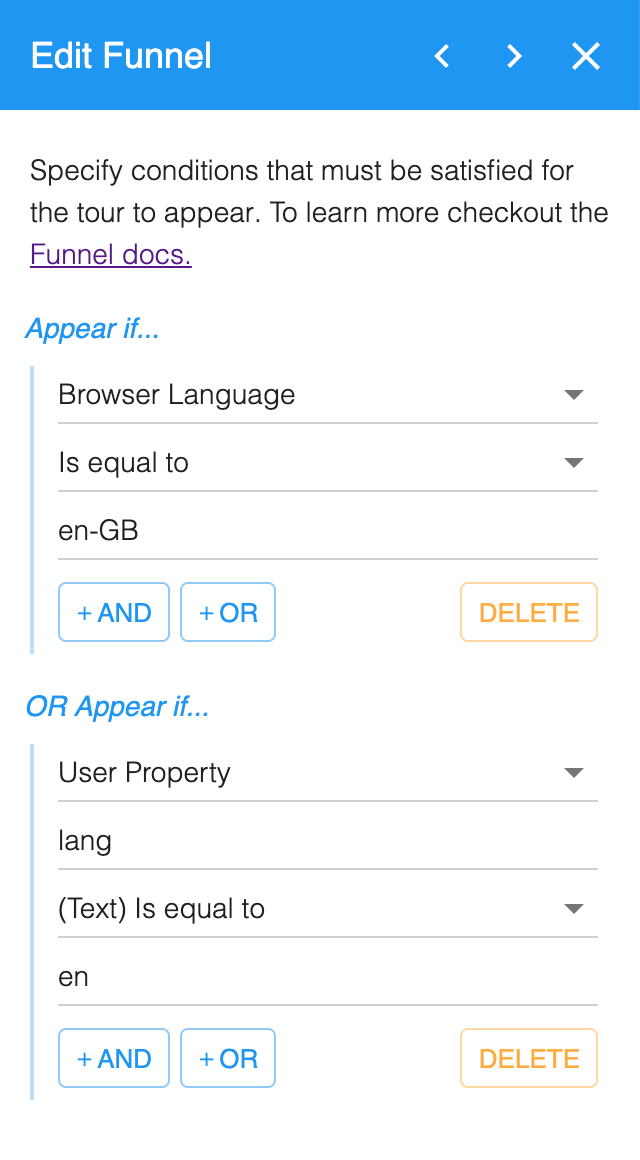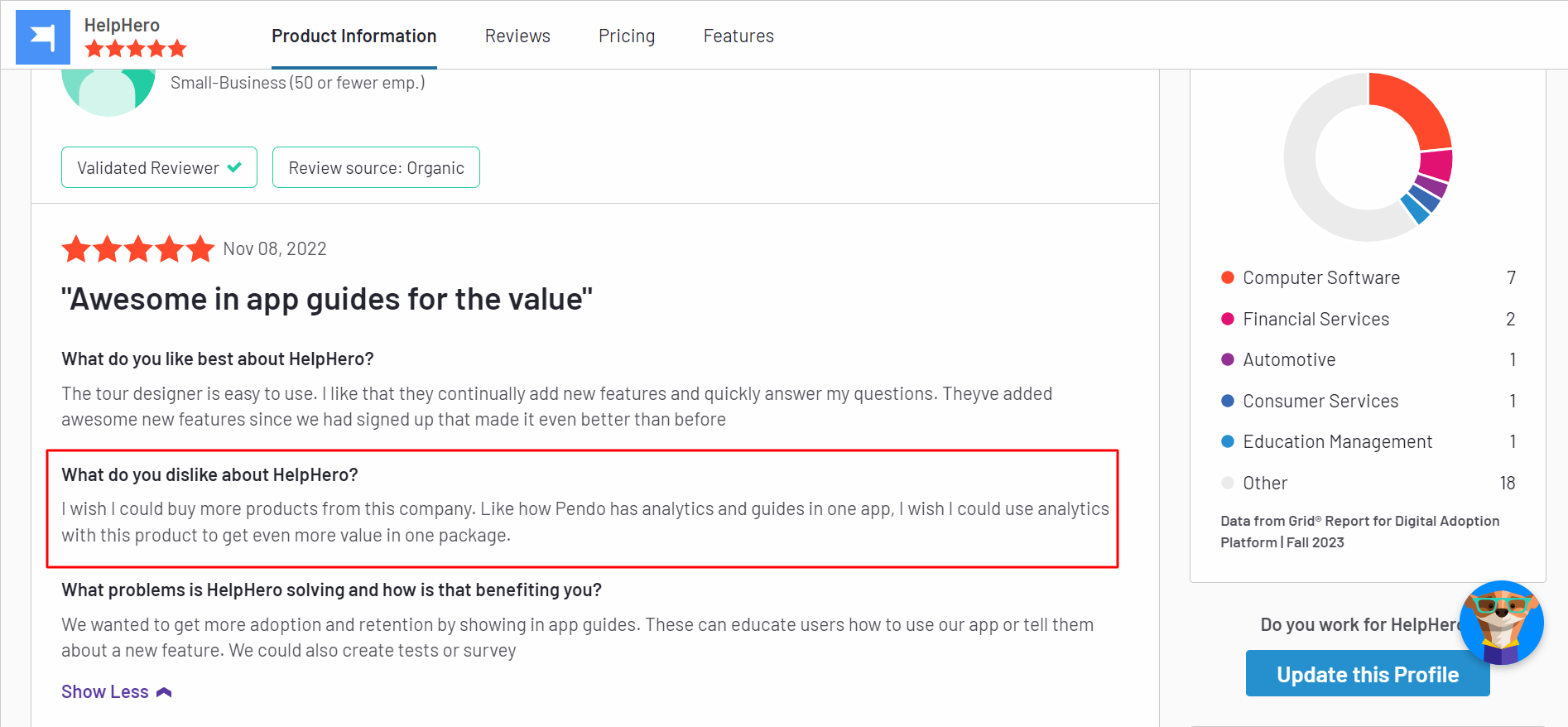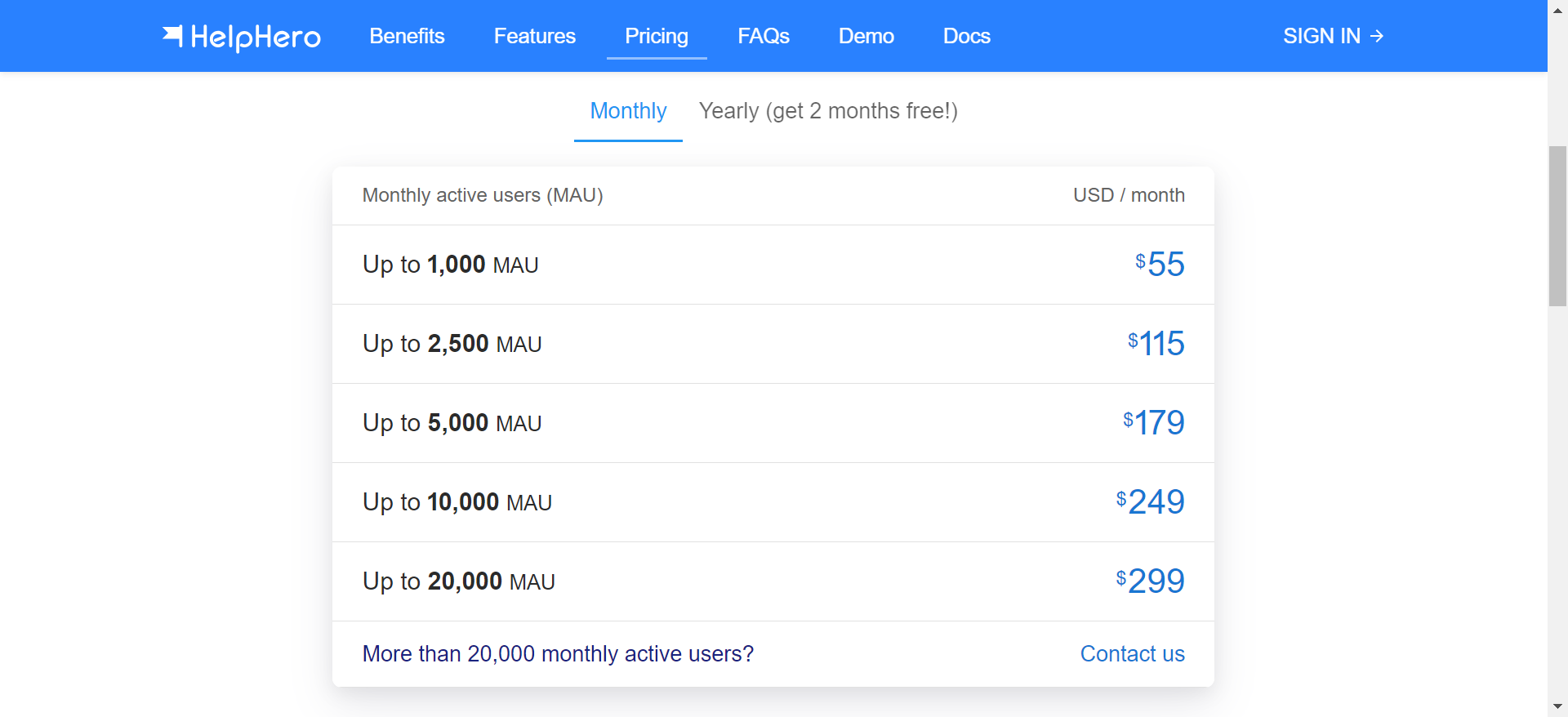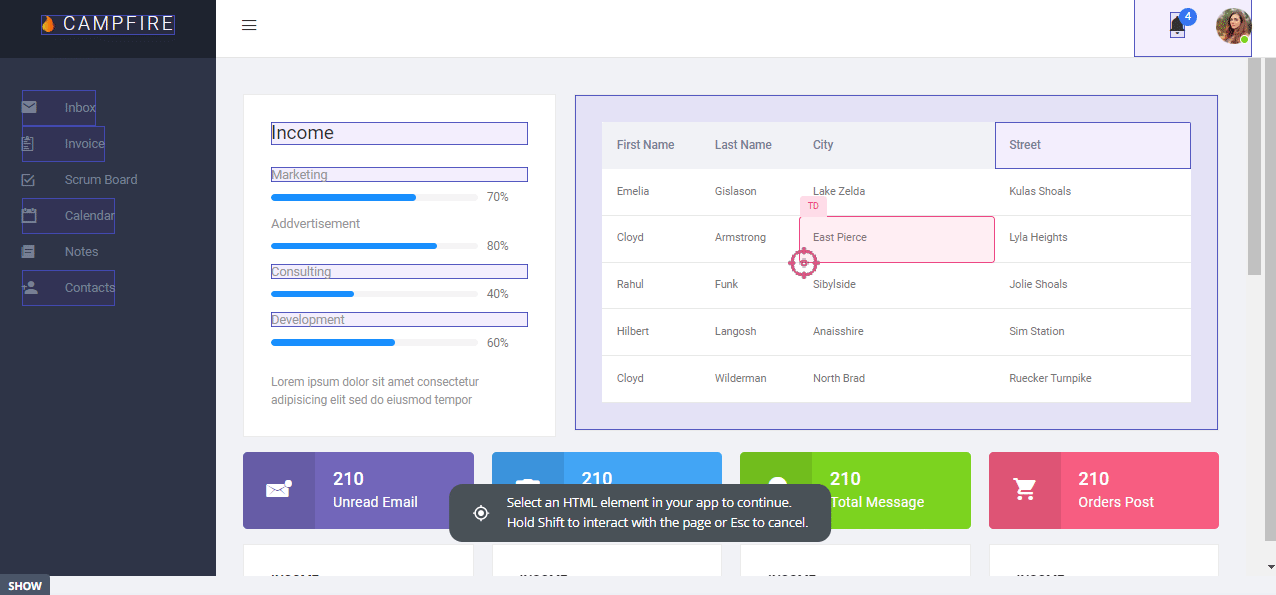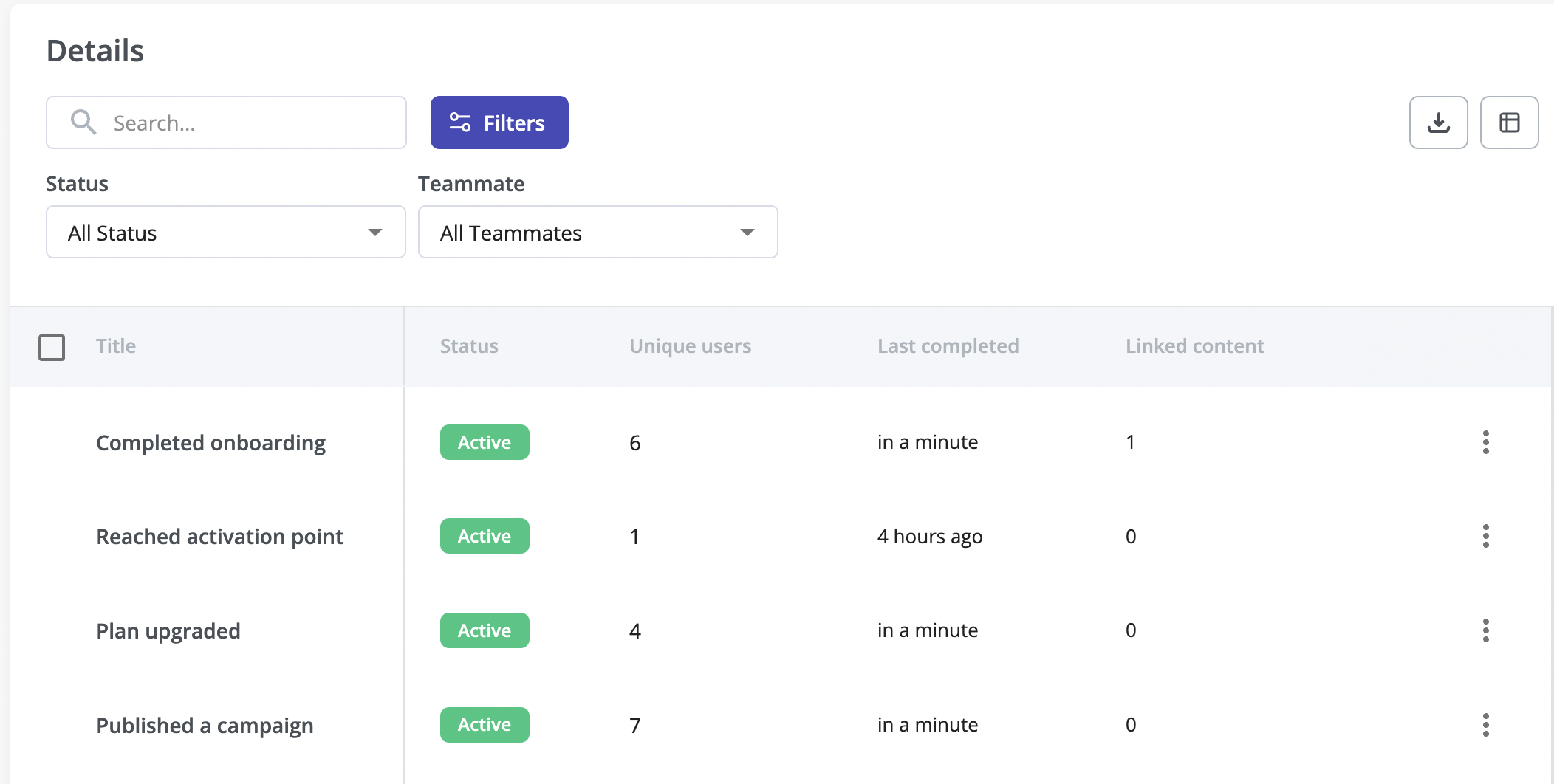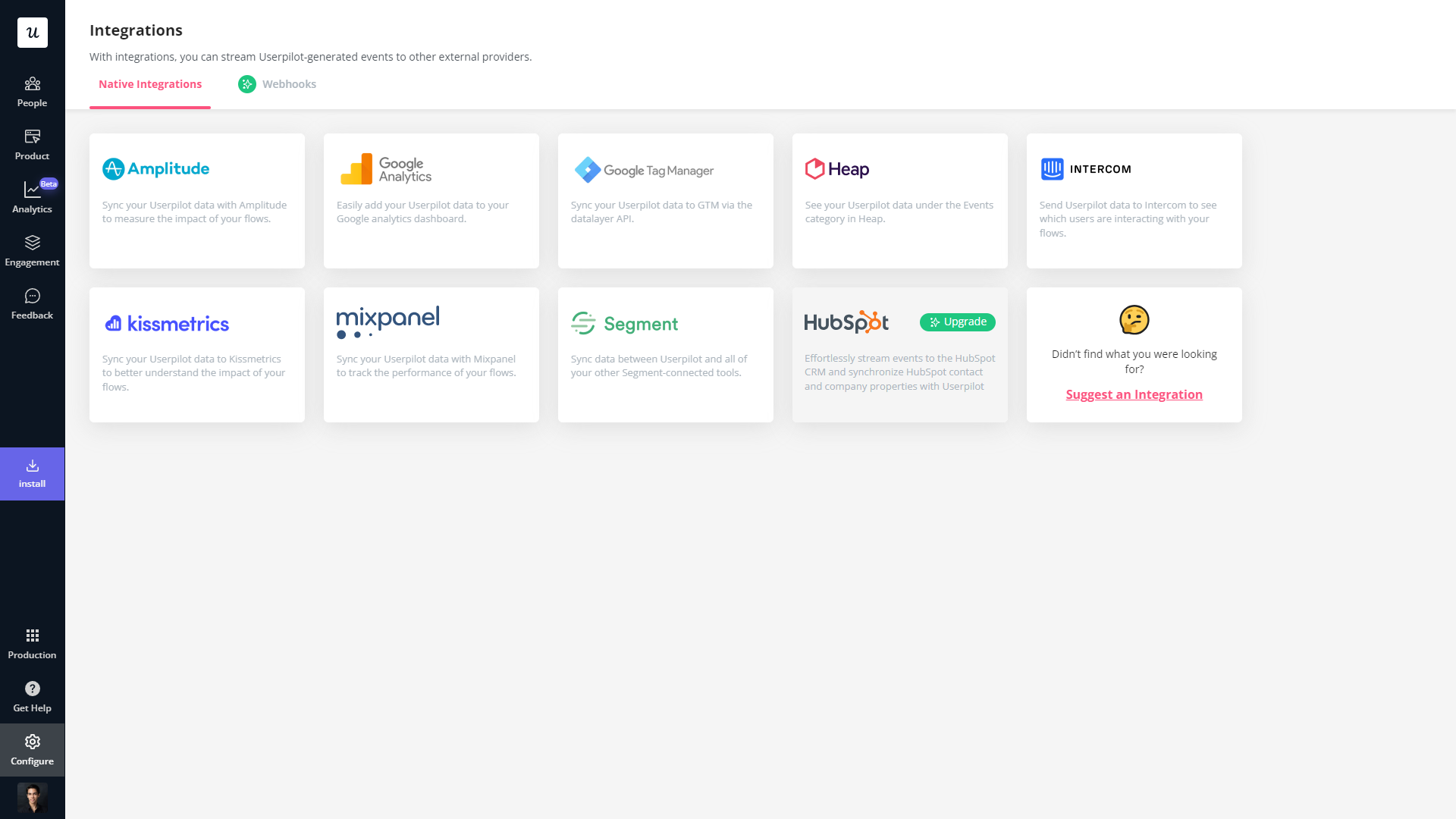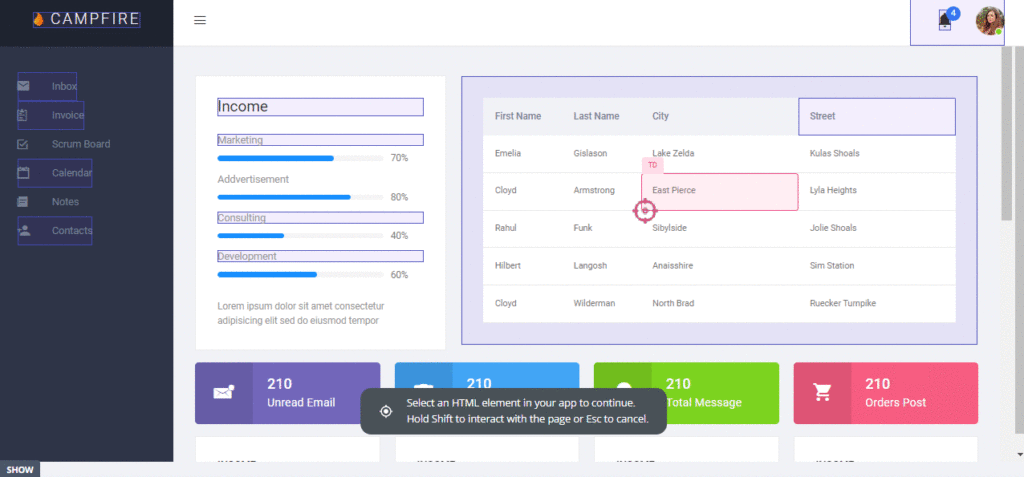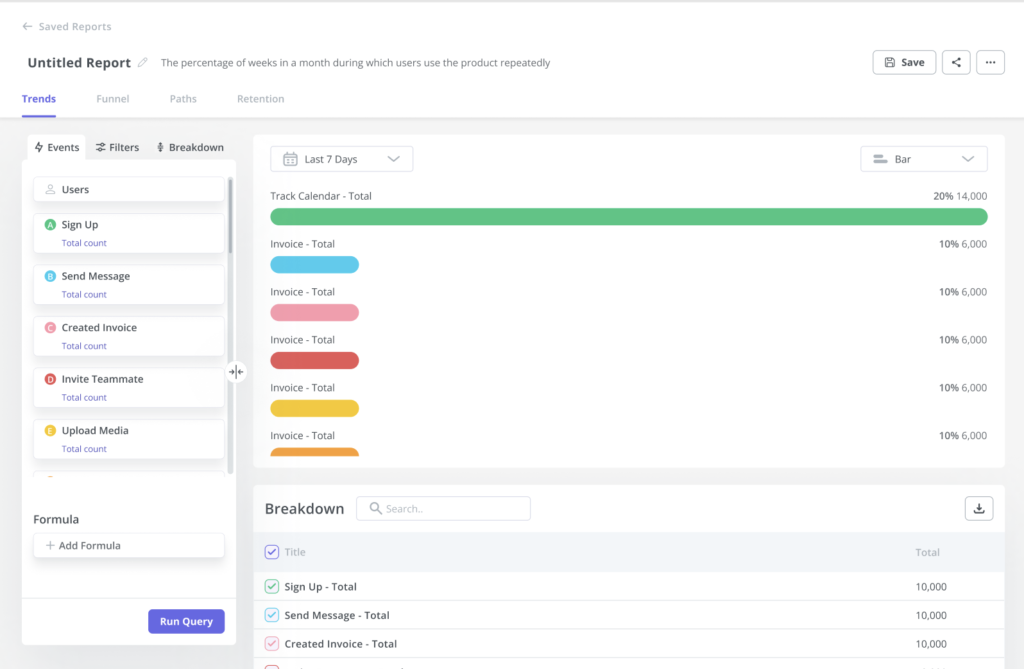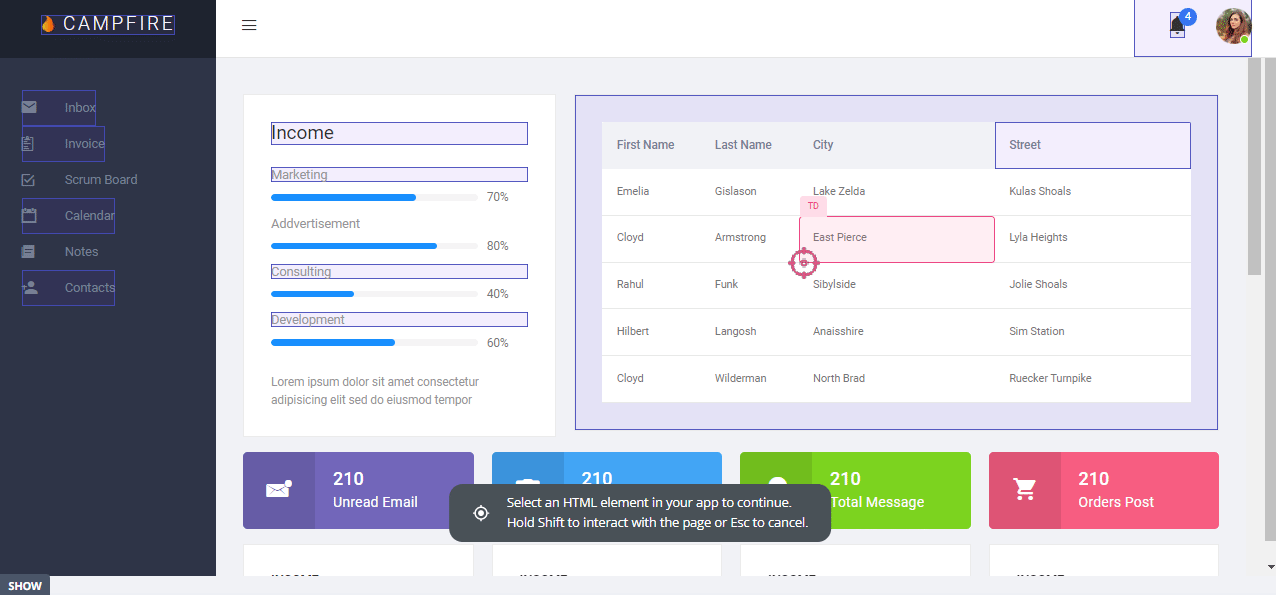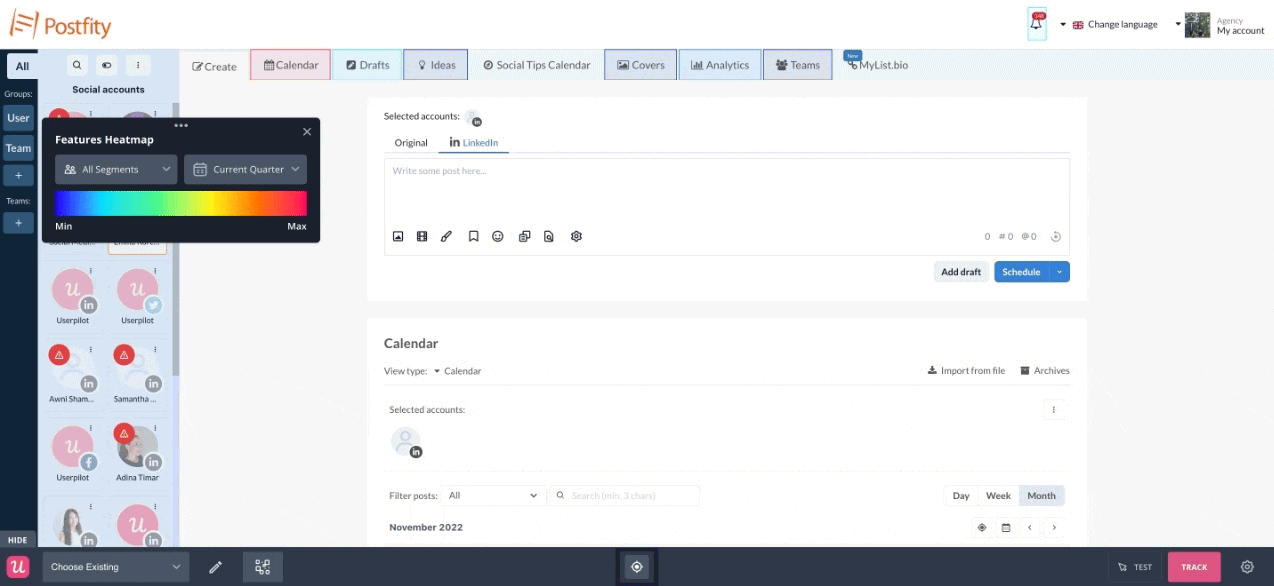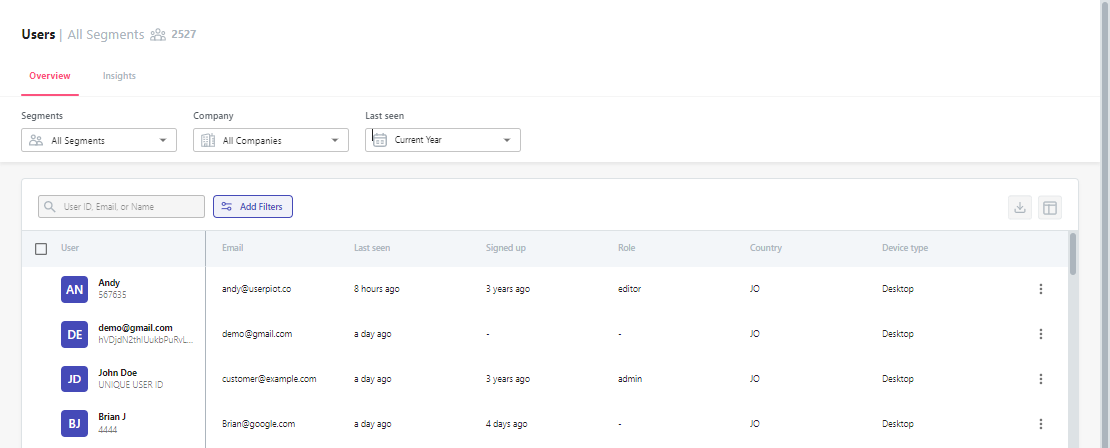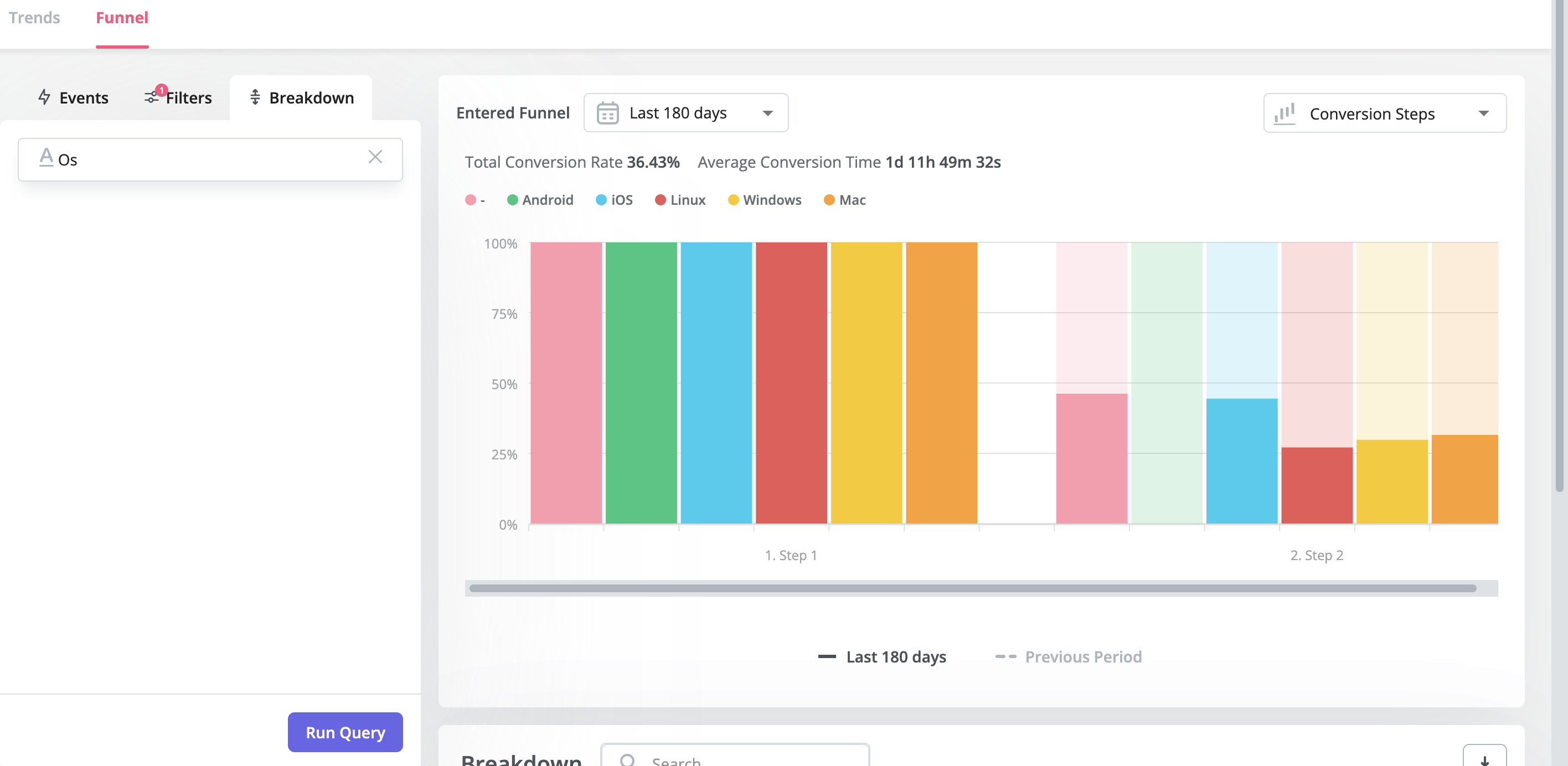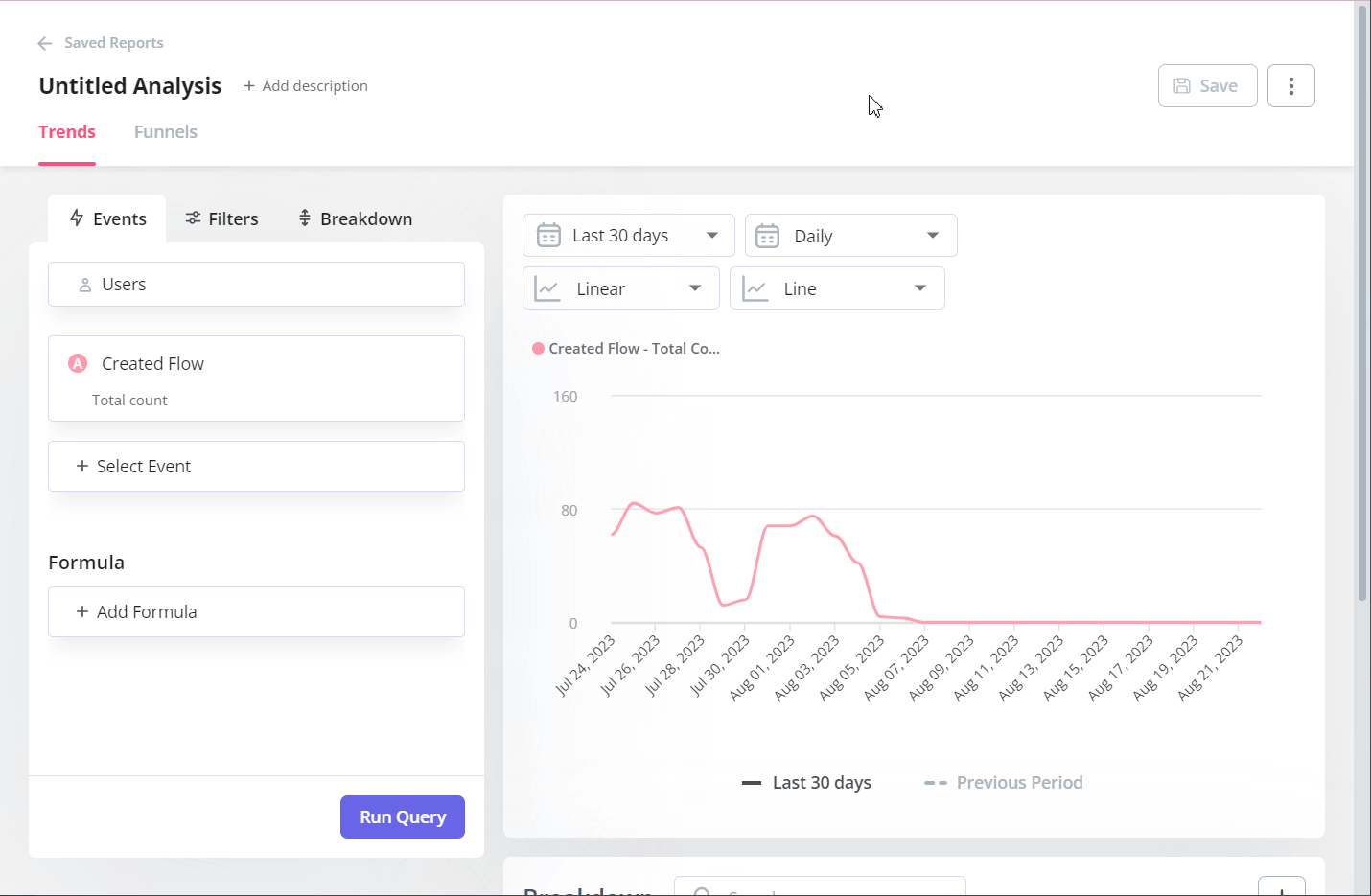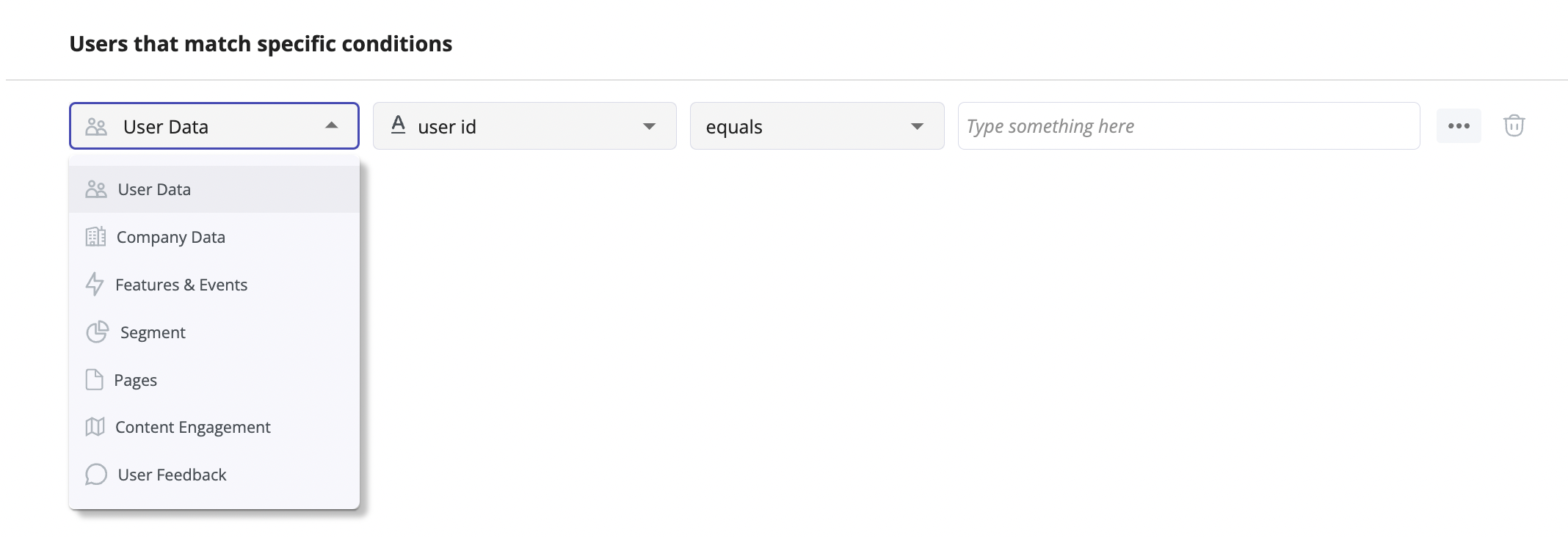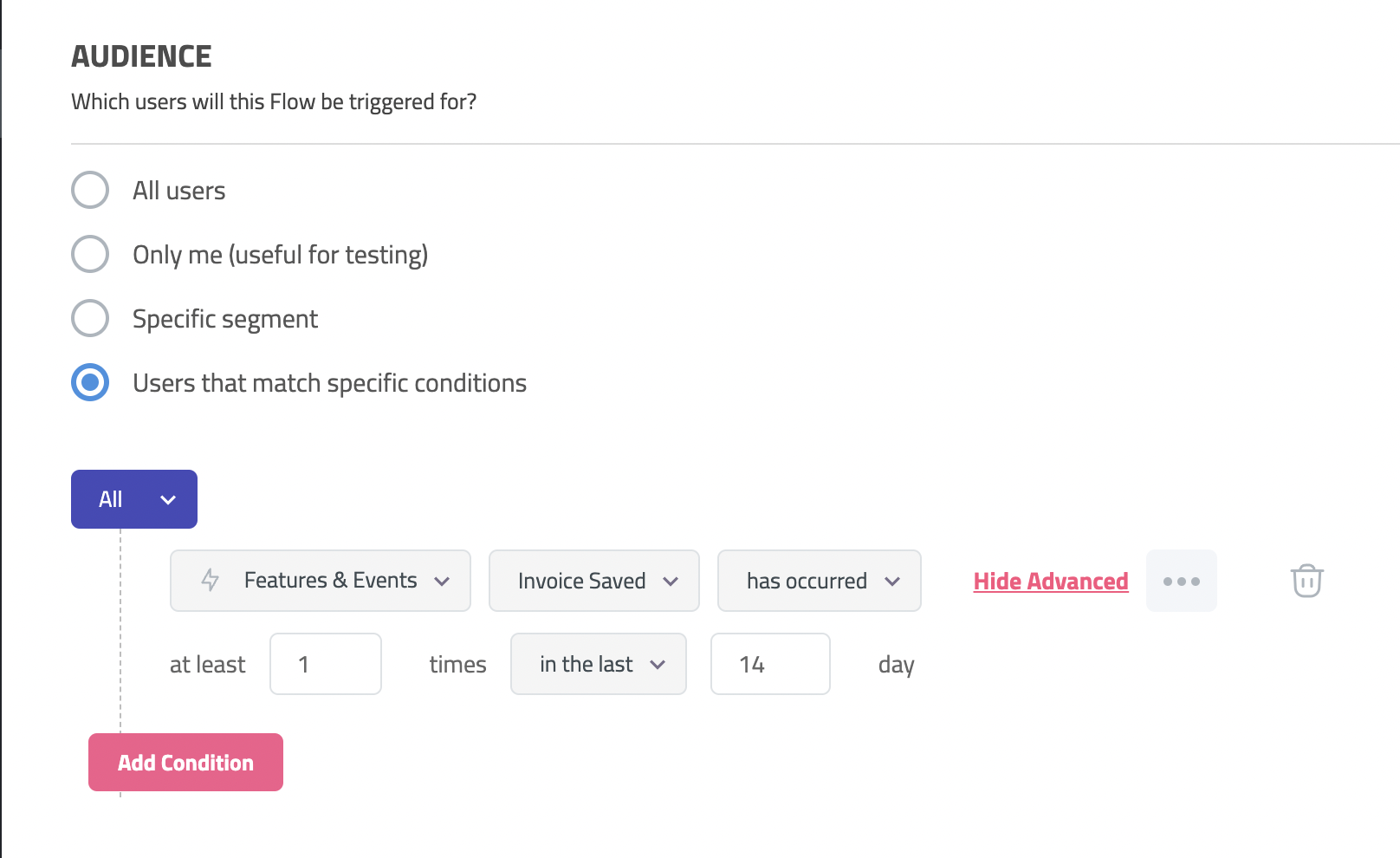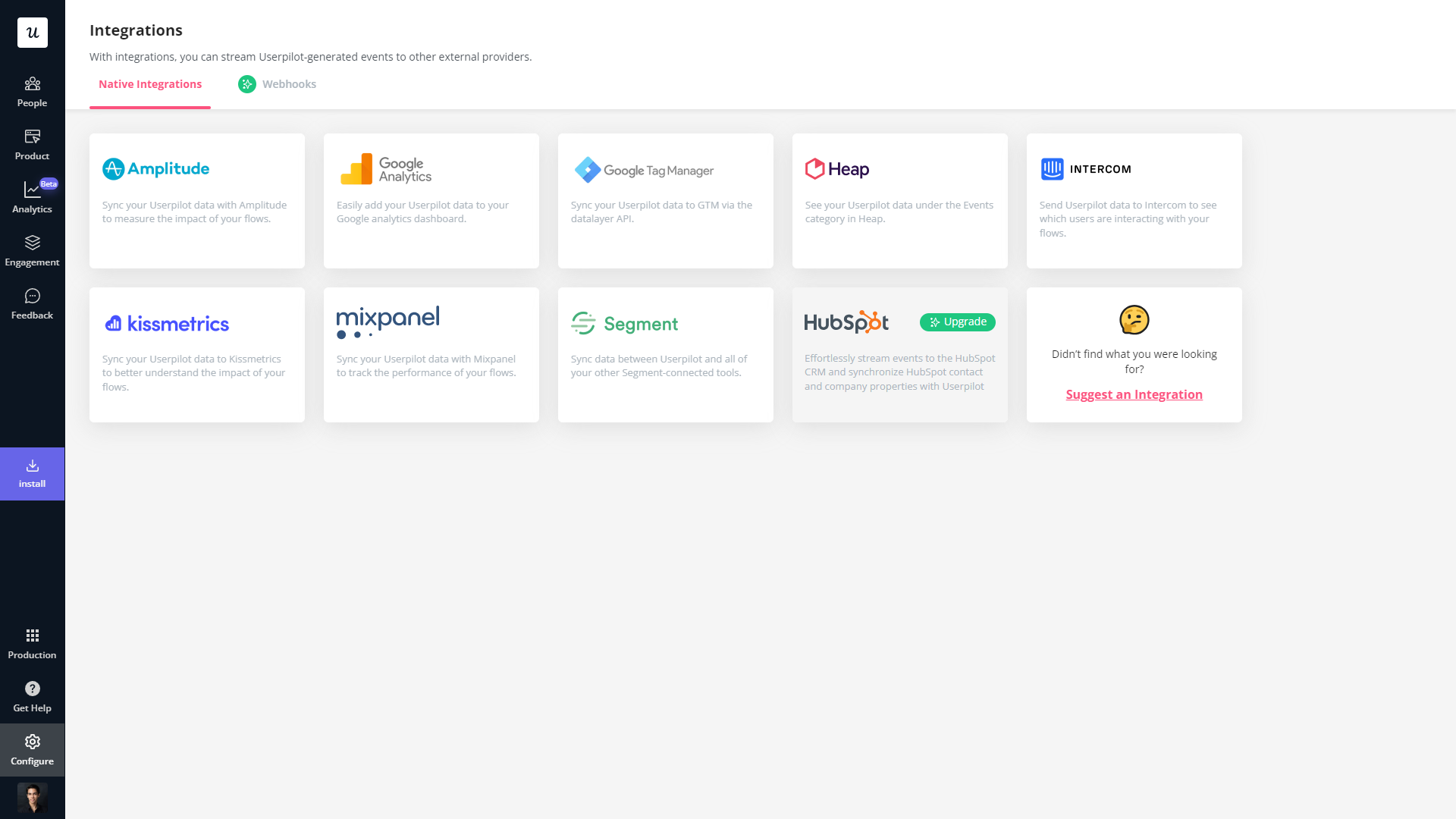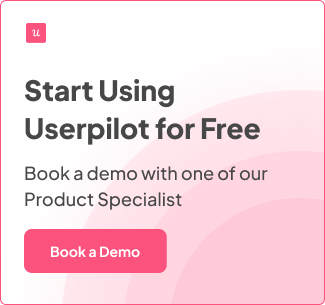HelpHero for Event Tracking: Features, Pricing, and Review
HelpHero for event tracking – quick summary
- HelpHero is a good choice for event tracking and it comes with features such as behavioral analytics, feature tags, user journey mapping, and user segmentation.
- Let’s look at the most common limitations of HelpHero and why you might need HelpHero’s alternatives:
-
- You want flexible user onboarding flows: HelpHero’s user onboarding features primarily support linear paths with minimal branching capabilities. This limitation can hinder the creation of more sophisticated and adaptable onboarding experiences, which is crucial for addressing the diverse needs of users.
- You want advanced interactivity options: HelpHero’s onboarding tools are somewhat restricted when creating interactive elements beyond basic text copy and buttons. To engage users effectively, especially in complex or feature-rich applications, a lack of interactive components can be a significant drawback.
- Inability to address specific user queries: HelpHero’s onboarding flow doesn’t allow users to drill into specific issues or questions they may have during the onboarding process. This limitation can make it challenging to provide real-time assistance and guidance to users, potentially leading to frustration or increased support requests.
- If you’re looking for a better option for event tracking, Userpilot exceeds both functionality and value for money compared to HelpHero.
- Ready to see Userpilot in action? Schedule a demo today to explore its powerful event tracking capabilities firsthand.
What is HelpHero?
HelpHero is a tool that enables businesses to build interactive, easy-to-follow product tours that help engage users from day one and speed up feature adoption quicker than ever.
In addition, with HelpHero, you can easily create and customize walkthroughs without coding. You can use it to ensure users know what’s new and how to use it. The result – is less frustration and confusion and higher user adoption and retention.
Must have features of event tracking tools
Here’s what to look for when opting for event-tracking tools:
- No-code tracking – such as tracking user clicks, hovers, and form infills to understand the impact of your in-app flows on your growth goals and feature adoption.
- Custom events – including actions such as compelling account setup, setting up payment methods, and creating workflows to track feature usage and overall adoption progress.
- Goal tracking – tracking the optimal result or specific action, tracking users that achieved an event to measure how your flows are influencing user behaviors, including activation moments, feature adoption, upgrades, etc.
- User segmentation – such as new customers, free trial users, lifetime free users, power users, inactive customers, users with low MRR, users with low NPS, and churned users to understand them on a deeper level and create personalized in-app experiences.
- Integrations – to collect data across your tools and get more in-depth analytics.
HelpHero features for event tracking
Event tracking is vital for a nuanced understanding of how users interact with your digital products. From button clicks to form submissions, tracking these events provides data that can inform UI improvements and feature development
Does HelpHero help you track events? Yes! How? Let’s take a look at two vital features:
- Funnel setup: You can track each event as a user property, so you can set up a tour to only show if the user has visited the page more than 3 times. In the HelpHero Editor, edit your tour and make sure you add a new funnel step after the first URL match.
- Coding/scripting: You can code your event tracking the way you want it. For example, you can add a script to the checkout page that will call HelpHero.update() after your HelpHero installation scripts. This example checks to see if the user already has a checkoutVisits property; if so, the script will add 1 to the visit count; otherwise, it will start the count from 1.
The drawback of HelpHero in event tracking is it’s not exactly code-free.
Alternatives like Userpilot offer no-code trackings, such as tracking user clicks, hovers, and form infills to understand the impact of your in-app flows on your growth goals and feature adoption.
HelpHero’s behavioral analytics
Behavioral analytics or user and entity behavior analytics is a data analysis process that focuses on understanding how users interact with your product.
HelpHero’s analytics helps you understand how viewers are interacting with your tours, so you can identify opportunities for improving user experience.
HelpHero’s feature tags
Feature tagging is foundational to understanding the impact of your in-app flows on your growth goals and feature adoption. It allows you to track the behavior of your users in your app, code-free and with no interference from your dev team.
Feature tagging is not available on HelpHero. However, with Userpilot, you can access advanced analytics.
HelpHero’s user journey mapping
A journey map is a visual representation outlining the entire customer experience from discovery to conversion and beyond.
However, HelpHero doesn’t offer user journey mapping capabilities. You will need a more advanced tool for this.
HelpHero’s user segmentation
HelpHero serves as an instrumental tool for user segmentation in SaaS onboarding, ensuring users receive a customized introduction to the product.
HelpHero offers several features for user segmentation, which are integral to its functionality as a customer onboarding tool. Here are three key points regarding its user segmentation capabilities:
- Organizes Users into Predefined Groups: HelpHero enables the organization of users into predefined groups, offering tailored responses based on the characteristics of each group. This feature facilitates targeted communication and a more personalized user experience
- Behavior-Responsive Messaging: The platform includes behavior-responsive messaging, allowing for the delivery of messages and prompts based on specific user actions or behavior patterns. This capability ensures that users receive relevant information and guidance immediately.
HelpHero cannot be used for advanced user segmentation. To choose the best user segmentation software, you should look for a tool to segment users based on many factors. Software that has analytics features and in-app experience builders are bonuses. Userpilot comes with advanced customer segmentation, NPS surveys, feature tagging, event triggering, and more.
What are the pros and cons of HelpHero?
HelpHero’s pros
HelpHero is an effective tool in the world of user onboarding and product adoption. Let’s dive into the pros of using HelpHero:
- Intuitive No-Code Product Tour Builder: HelpHero provides an easy-to-use, no-code builder that simplifies creating onboarding and product adoption flows.
- Diverse UI Patterns: With HelpHero, you have many UI patterns. Whether you prefer banners, tooltips, hotspots, or checklists, you can customize your user engagement just as you want. Regardless of your plan, you’ll have access to all UI patterns, ensuring you get value right from the entry-level plan.
- Engaging Walkthroughs: Create interactive walkthroughs tailored to specific user segments, making onboarding a breeze and driving product adoption.
- In-App Help: HelpHero enables you to build a resource center with self-service support, which can be customized to match your branding. You can choose from various help options, including videos, in-app flows, chat, and more.
- Easy & Affordable: HelpHero is a powerful and easy-to-use onboarding tool that is also cost-effective.
- Advanced Customer Support: With a comprehensive system, you can give users the guidance they need before they ask for it with contextual product tours.
- Onboarding Analytics and Segmentation: Analyze product usage and in-app flow engagement with HelpHero’s advanced analytics. You can also create user segments based on this data, allowing for highly targeted user interactions and improvements in the user experience.
HelpHero’s cons
Overall, HelpHero is a good customer onboarding software, but it has a few limitations that make it less than ideal for some businesses.
- Limited Features: HelpHero does not offer all of the features that some businesses need for customer onboarding, such as the ability to create custom onboarding flows or to track customer progress in real-time.
- Limited Customization Options: HelpHero’s customization capabilities are limited, which may not suit businesses with unique branding or design needs.
- A/B Testing is only available to technical users who can code.
- Integration Challenges: Integrating HelpHero with certain software and systems can be more complex and less seamless than some alternatives.
What do users say about HelpHero?
Does HelpHero offer a great onboarding and walkthrough experience? Let’s see a good review of HelpHero on G2:
“Easy and fast way to implement onboarding for your apps”
Very easy to implement onboarding tutorials, almost no technical skills needed. Windows can target CSS elements. Powerful funnel system. Cheapest solution of this kind I have found.
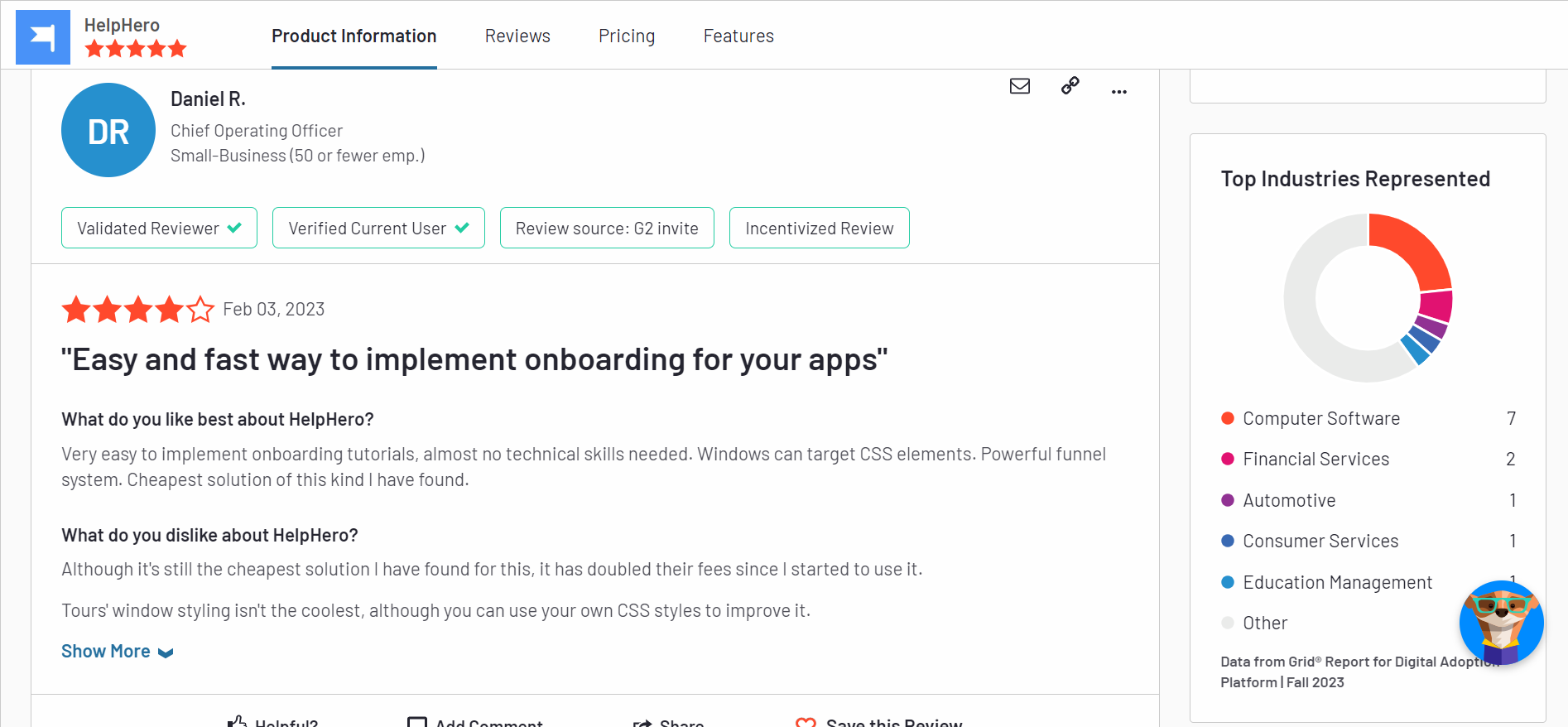
Although it’s still the cheapest solution I have found for this, it has doubled their fees since I started to use it.
Tours’ window styling isn’t the coolest, although you can use your own CSS styles to improve it.
HelpHero’s pricing
HelpHero’s pricing plan is based on the number of Monthly Active Users (MAUs). Here’s an overview of the different pricing plans, including the free trial:
- HelpHero free trial: free 14-day trial, no credit card required.
- Up to 1000 MAU — $55
- Up to 2500 MAU — $115
- Up to 5000 MAU — $179
- Up to 10000 MAU — $249
- Up to 20000 MAU — $299
- If you have more than 20,000 Monthly Active Users, you have to contact them.
3 Reasons why you might need a HelpHero alternative
Let’s look at the most common limitations of HelpHero and why you might need HelpHero’s alternatives:
- You want flexible user onboarding flows: HelpHero’s user onboarding features primarily support linear paths with minimal branching capabilities. This limitation can hinder the creation of more sophisticated and adaptable onboarding experiences, which is crucial for addressing the diverse needs of users.
- You want advanced interactivity options: HelpHero’s onboarding tools are somewhat restricted when creating interactive elements beyond basic text copy and buttons. To engage users effectively, especially in complex or feature-rich applications, a lack of interactive components can be a significant drawback.
- Inability to address specific user queries: HelpHero’s onboarding flow doesn’t allow users to drill into specific issues or questions they may have during the onboarding process. This limitation can make it challenging to provide real-time assistance and guidance to users, potentially leading to frustration or increased support requests.
Userpilot – A better alternative for event tracking
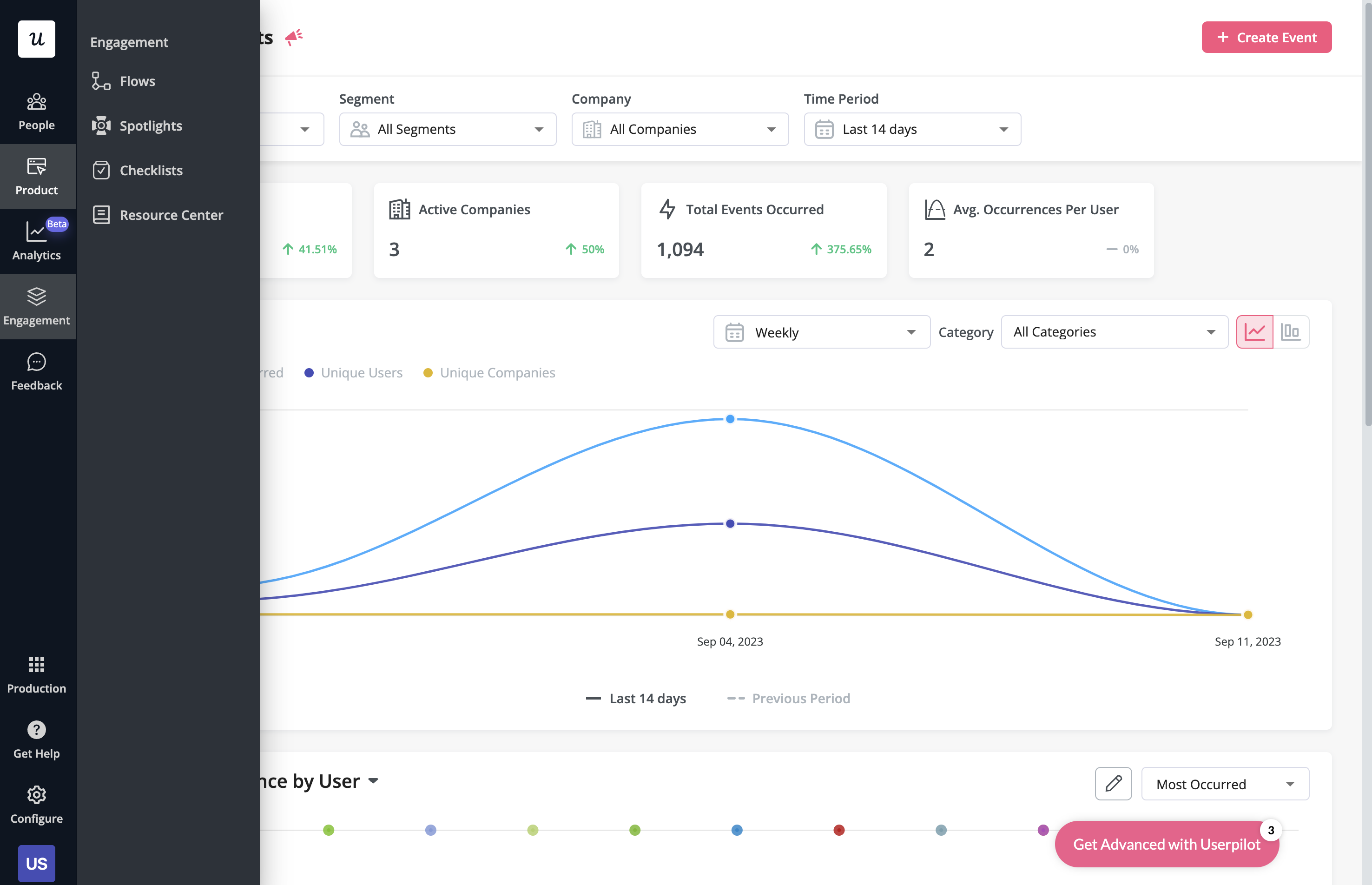
Here’s how you can use Userpilot as an event-tracking tool:
- No-code tagging: Userpilot’s no-code tagging capabilities let you set up event tracking for buttons, features, and elements. You can track clicks, hovers, or user inputs. You’ll also be able to group multiple events as a custom event to give you more accurate insights.
- Event goals: The Goals dashboard will let you track how many users have performed a desired action. You can also track users who have completed a specific event and see how that impacts other aspects of their journey down the line, such as feature usage or upsell events.
- Third-party integrations: Userpilot integrates with dedicated analytics tools like Amplitude, Mixpanel, Heap, and more. This lets you seamlessly stream event data to other tools in your tech stack and get a clearer view of key events across the entire user base.
Userpilot’s behavioral analytics
Behavioral analytics make it possible to monitor user activity, group data into cohorts, and extract relevant metrics/insights. Userpilot lets you tag features to see how users interact with them, compare goals by cohort, and create trend reports that track behavioral patterns over time.
Here are some Userpilot features you can use for user behavior tracking:
- No-Code Feature Tagging: Userpilot’s click-to-track feature tagger lets you mark features, buttons, and elements with the Chrome extension. You’ll be able to track user interactions such as clicks, hovers, or inputs to get an accurate behavioral view for specific features.
- Funnel Reports: Funnel reports show you the total number of users that enter a funnel and the percentage of users that complete each step. This can help you track behavioral paths and see which stages most users get stuck on.
- Trends Reports: Generating trends reports will help you visualize the occurrence of key events over time and break down these analytics by device, browser, operating system, country, signup date, or even individual user IDs and email addresses to see granular behavioral analytics.
Userpilot’s feature tags
Tracking feature adoption is essential to identify under-utilized features and push users toward discovering them. Userpilot lets you tag features without writing any code, track adoption through engagement analytics, and visualize feature usage with heatmaps.
Here’s how you can use Userpilot to conduct feature audits and drive feature adoption:
- No-code tagging: Userpilot’s no-code feature tagger lets you add tags through the Chrome extension’s visual builder. You’ll also be able to select whether the tag should track clicks, hovers, or text inputs from users to get contextual data that reflects actual feature usage.
- Feature tags: The advanced feature analytics of Userpilot lets you track feature performance trends, see the top 20 features across your user base, and see granular data for individual features. You’ll also be able to filter your data by segment, company, or time period.
- Usage heatmaps: Userpilot heatmaps show you the features/elements with the most interactions. Heatmaps can be generated on the Features & Events dashboard by clicking on a tagged feature, editing it in the builder, and then clicking the heatmap icon on the bottom toolbar.
Userpilot’s user journey mapping
User journey mapping helps you visualize all the interactions between users and your product as they try to achieve a particular goal. Userpilot’s detailed user analytics and funnel/trend reports help you track customers as they progress through different stages of their journey.
Here are the Userpilot features you can use for user journey mapping:
- User analytics: The Users dashboard provides detailed analytics of your entire customer base. You’ll be able to sort by segment, company, or time period and add multiple filters to help you narrow results. You can also perform bulk actions and export user data in a CSV format.
- Funnel reports: These reports help you visualize the user journey map by showing which stage, page, or action most users get stuck on. You’ll also be able to view breakdowns so you can see how the user journey changes depending on which OS, browser, or device type a user is on.
- Trend reports: Userpilot’s trend reports offer behavioral insights such as how often users perform a specific action, the number of unique users who take that action, and where in the user journey these actions occur. You can also create custom metrics and build your own charts.
Userpilot’s user segmentation
User segmentation is essential for creating a personalized and contextual onboarding experience. Userpilot can segment users based on demographics, product usage data, NPS scores, and more. You can then trigger flows or filter analytics based on segments.
Here’s an overview of Userpilot’s customer segmentation capabilities:
- Segment conditions: Userpilot lets you form segments by adding different conditions like user data, company data, features and events, etc. You can then use these segments as analytics filters or flow triggers later on.
- Analytics filters: Userpilot’s product analytics and user insights dashboards can be filtered to only display data from specific segments (or companies). This will help you extract insights from certain cohorts and compare how adoption or activation varies from one segment to the next.
- Flow triggers: Userpilot’s audience settings let you trigger flows for specific segments or target users that meet certain conditions. You can combine this with page-specific or event-occurrence triggers to show relevant flows to the right users at the most contextual moments.
- External data: Userpilot integrates with tools like Amplitude, Google Analytics, Mixpanel, and Segment using a one-way integration. This means you can use the data inside Userpilot to build advanced segmentation and trigger contextual experiences. For more advanced use cases, the two-way integration with Hubspot lets you send and receive data, unlocking a full set of use cases.
What are the pros and cons of Userpilot?
Userpilot pros
As a full-suite digital adoption platform, Userpilot has all the features you need to onboard users, track analytics, and gather feedback from customers without writing a single line of code. Here are a few pros of using Userpilot as your product growth solution:
- No-code builder: Userpilot’s Chrome extension lets you build flows, add UI elements, and tag features without writing a single line of code.
- UI patterns: There are plenty of UI patterns to choose from when using Userpilot, such as hotspots, tooltips, banners, slideouts, modals, and more!
- Startup-friendly: Userpilot’s entry-level plan gives you access to all available UI patterns so you can hit the ground running.
- Walkthroughs and flows: Build engaging interactive walkthroughs and personalized onboarding flows that target specific segments of your user base.
- Self-service support: Build an in-app resource center to help users solve problems, customize its appearance to align it with your brand, and insert various types of content (videos, flows, or chatbots) to keep your customers satisfied.
- A/B testing: Userpilot’s built-in A/B testing capabilities will help you split-test flows, iterate on the best-performing variants, and continually optimize based on user behavior.
- Feedback collection: Userpilot has built-in NPS surveys with its own unified analytics dashboard and response tagging to help you retarget users. There are other survey types to choose from and you can even create your own custom survey.
- Survey templates: There are 14 survey templates to choose from so you can gather feedback on specific features or run customer satisfaction benchmarking surveys like CSAT and CES.
- Advanced analytics: Userpilot lets you analyze product usage data, monitor engagement on all in-app flows, and use the data to create user segments that are based on behaviors instead of demographics.
- Event tracking: Userpilot’s no-code event tracking lets you tag UI interactions (hovers, clicks, or form fills) and group them into a custom event that reflects feature usage.
- Third-party integrations: Userpilot has built-in integrations with tools like Amplitude, Mixpanel, Kissmetrics, Segment, Heap, HubSpot, Intercom, Google Analytics, and Google Tag Manager so you can share data between all the solutions in your tech stack.
Userpilot’s cons
Of course, no tool is perfect and there are a few cons to consider before choosing Userpilot as your user onboarding or product growth solution:
- Employee onboarding: Currently, Userpilot only supports in-app customer onboarding.
- Mobile apps: Userpilot doesn’t have any mobile compatibility which could make it difficult for developers with cross-platform applications to create a consistent user experience for both versions of their product.
- Freemium plan: There’s no freemium Userpilot plan so those bootstrapping their startup and need sub-$100 solutions should consider more affordable onboarding platforms like UserGuiding or Product Fruits.
What do users say about Userpilot?
Most users laud Userpilot for its versatile feature set, ease of use, and responsive support team:
I recently had the pleasure of using Userpilot, and I must say it exceeded all my expectations. As a product manager, I’m always on the lookout for tools that can enhance user onboarding and improve overall user experience. Userpilot not only delivered on these fronts but also went above and beyond with its impressive new features, unparalleled ease of use, and truly exceptional customer support.
What truly sets Userpilot apart is its outstanding customer support. Throughout my journey with Userpilot, the support team has been responsive, knowledgeable, and genuinely dedicated to helping me succeed. Whenever I had a question or encountered an issue, their support team was always there to assist promptly, going above and beyond to ensure my concerns were addressed effectively.
Source: G2.
Of course, other users are also kind enough to share constructive criticism regarding specific features like event tracking filters:
“The filtration while analyzing specific events is a little confusing. Understanding of custom properties and data management configuration could have been more organised.”
Source: G2.
Userpilot’s pricing
Userpilot’s transparent pricing ranges from $249/month on the entry-level end to an Enterprise tier for larger companies.
Furthermore, Userpilot’s entry-level plan includes access to all UI patterns and should include everything that most mid-market SaaS businesses need to get started.
Userpilot has three paid plans to choose from:
- Starter: The entry-level Starter plan starts at $249/month and includes features like segmentation, product analytics, reporting, user engagement, NPS feedback, and customization.
- Growth: The Growth plan starts at $749/month and includes features like resource centers, advanced event-based triggers, unlimited feature tagging, AI-powered content localization, EU hosting options, and a dedicated customer success manager.
- Enterprise: The Enterprise plan uses custom pricing and includes all the features from Starter + Growth plus custom roles/permissions, access to premium integrations, priority support, custom contract, SLA, SAML SSO, activity logs, security audit, and compliance (SOC 2/GDPR).
Conclusion
There you have it.
It should be easier now to make an informed decision whether HelpHero is your go-to option for event tracking. Ultimately, the best choice will depend on your product and current needs.
If you’re looking for a better alternative to HelpHero for event tracking, book a Userpilot demo today to experience firsthand how it can enhance your user experience and drive product growth!
Looking for a Better Alternative for Event Tracking? Try Userpilot

